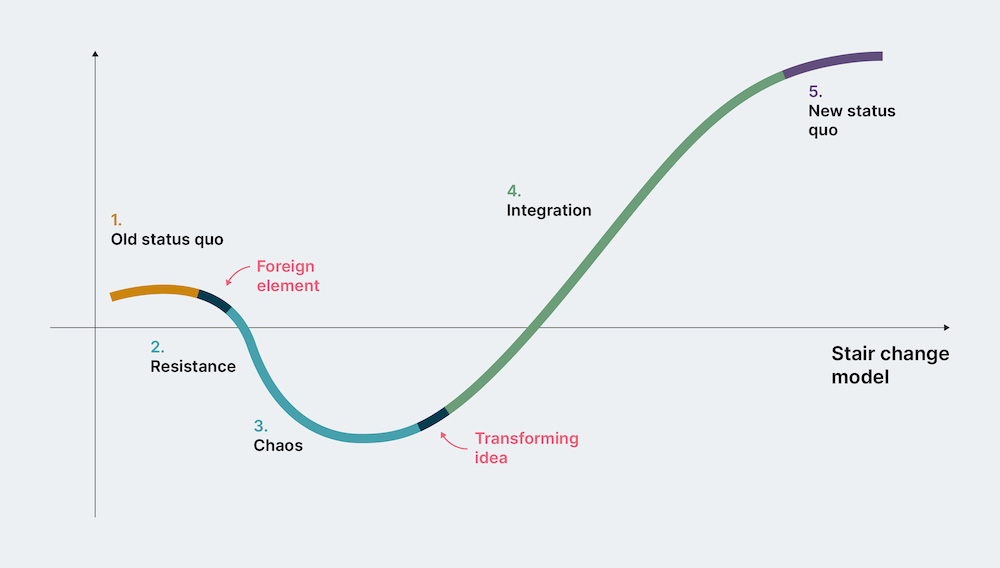Any organizational transformation program entails significant changes to the lives of the organizations’ employees. As transformation consultants, one of our primary responsibilities is to help the leadership in the organization understand their role in guiding their employees through this change.
More often than not, leaders understand the need for change as well as the need for external advisors to provide the expertise that isn’t available in the organization. It is natural for them to assume that the external advisors will also be able to convince the managers and employees of the reasons and urgency for the change along with the introduction of expert knowledge and techniques. However, this assumption often becomes the primary reason for failure for many transformation projects.
Leaders in the organization need to play an active role in designing and communicating the change to managers and employees alike and this is no small undertaking. Here are a few responsibilities that the organizational leadership has to bear to increase the chances of success for a transformation :
1. Co-create the change
In today’s world, vast amounts of knowledge on almost any subject is easily available through books, blogs, videos and podcasts, but only knowledge isn’t enough. For example, knowledge about agile methodology is fairly ubiquitous in the software development industry, including some predefined frameworks on how to implement it. Yet, smart organizations with smart people still fail to implement it well. Similar failures have been observed for other changes which are initiated only on the basis of theoretical knowledge / predefined frameworks.
The reason for such failures is every organization has a distinct culture and power dynamic that plays a huge role in accepting / rejecting change. So the nature of change has to be adjusted to suit the situation. This involves two ingredients:
Deep expertise on the subject (the change in question)
Deep understanding of the organization, its culture and power dynamics
The second ingredient is what leaders bring to the table without which it is impossible to design a lasting change. For example, as a transformation team, where do we have influence and where not? Are there other changes in progress that might be in conflict with the transformation? What are different groups measured on and hence what will help them adopt the change?
2. Generate alignment on the need and nature of change
Transformations are triggered when the business is unable to create or maintain competitive advantage / operational efficiency. The leaders in the organization experience these bottlenecks and leaks day-to-day, hence, they are best placed to articulate the reason for the transformation. Understanding the 'why' behind the transformation and communicating that to others in the organization is a crucial role that leaders need to play. To do this well, they not only need to understand the 'why' from an organizational standpoint but also 'why' the change is going to be beneficial to each employee involved.
To generate alignment from the beginning, internal leaders should be made aware of the problem the organization is trying to solve and engaged to come up with better suggestions if possible. Some leaders will have ideas but will not have the bandwidth, while others may not have a clear idea of how to approach the problem. By throwing a challenge before the the start of such an engagement, both kinds of leaders will be aligned on the need for the change and its urgency.
3. Govern and steer the program
Since leaders best understand the change required, they are also best placed to spot when things are working / not working. By owning the governance they can steer the program in the right direction. It also sends a message to the rest of the organization that the change program is important to the leader and the organization.
These governance meetings are also the right place to reiterate the need and urgency of the change, for everyone involved. Things change as the transformation progresses and initial assumptions might be invalidated. Steering meetings are a way to realign people on the purpose and the way forward, with tangible actions, in wake of the current reality.
4. Amplify and spread the impact
An important aspect of governance is to amplify and cross pollinate good ideas and successes. Leaders are likely to have a view across multiple business units / functions / departments and can catalyze change throughout the organization by spotting and replicating patterns that work for the pilot cohort.
At HealthEdge, we used the joint showcase meetings, the engineering manager’s meeting as well as the company town hall, for this purpose. The leaders in the organization also sent out emails according to a predefined schedule, bringing attention to specific practices / techniques that were working well and benefitting the organization.
5. Make space for change
All transformations require businesses to change while running. It is often described as changing the engines on an aeroplane while it’s in flight. It is absolutely true that you can’t stop a business in order to transform it. In fact if you attempt this, the changes probably won’t hold because they were made in a controlled environment that isn’t representative of the real world.
However, it is also a folly to assume that the change won’t cause any disruption at all! People will take time to understand, accept and start living the change. The ecosystem around them will have to adjust to the new normal. This will cause a productivity dip that needs to be accounted for. For agile delivery teams this usually translates to lower velocity. For business this means slowing down development of new features. This is a bitter pill to swallow but it is better to accept the fact and factor it in rather than plan assuming business will continue as usual throughout the transformation.


Satir change model
Apart from accounting for the dip in productivity, the organization should also account for the capacity of the people playing an active role in the transformation. This is not a role that can be tacked on to existing responsibilities of senior leaders in the organization.
6. Remove systemic hurdles
While the actual transformation efforts are likely to be focused on a small cohort, the challenges faced by that cohort will often point to systemic issues. These systemic issues are well beyond the control of the cohort. Senior leaders are best placed to understand these issues and make larger changes in the organization to fix them. Fixing these issues during the pilot is a great way to improve chances of success when it’s time to implement the change at scale.
Imagine an engineering team trying to reduce the spillover from one sprint to another. This can be done by carrying out a technical analysis of the user stories in the preceding sprint. But if the Product Management team is providing priorities just before the sprint starts, the engineering team may not be able to do the required technical analysis. The Product Management team may itself be helpless in case of a customer with high bargaining power. In such a scenario, improving engineering performance will have to start with a discussion with the customer. Such a hurdle can only be solved by leaders with an appropriate level of influence and authority.
7. Plan for sustainability
Any transformation initiated with the help of external advisors is prone to stall / fail when they disengage. One of the biggest ways in which leaders can increase the chances of success is by forming an internal team with the mandate to sustain the change. Such a team should ideally be formed right at the beginning of the transformation so that it can act as a partner to the external advisors throughout the change program.
Another key method of sustaining transformations is to create a method of governance with the right metrics and behaviours being measured. Setting up such a framework and continuing governance along those lines is the last key responsibility of organizational leaders.
In conclusion, any transformation is a big investment. To get a good return on these investments, it requires the leaders in the organization to own the outcomes and craft the change alongside external advisors. It also needs a solid coalition of leaders relentlessly converting theory to reality and adapting the plan as necessary. This requires people who are great at their current job of 'running the business' to spend time on 'changing the business.' The opportunity cost involved needs to be well understood to prepare a proper business case for transformation.
The more intentionally you approach a transformation the better are your chances for success.
Disclaimer: The statements and opinions expressed in this article are those of the author(s) and do not necessarily reflect the positions of Thoughtworks.


















